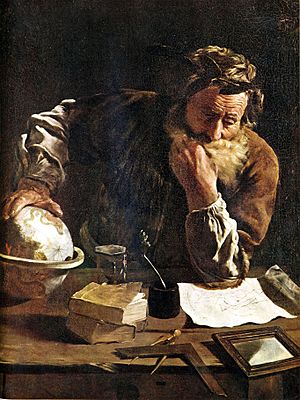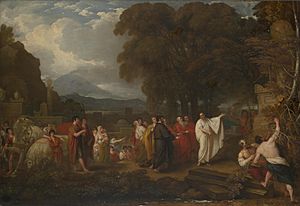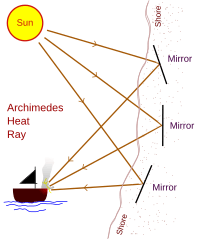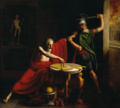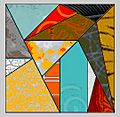Archimedes facts for kids
Archimedes (born around 287 BC, died around 212 BC) was a famous Greek scientist. He was a brilliant inventor, an astronomer, and a mathematician. He was born in the city of Syracuse in Sicily.
Contents
Biography
Archimedes was born around 287 BC in Syracuse, a rich Greek city in Sicily. His father, Phidias, was an astronomer. Some people believe Archimedes might have been related to the king of Syracuse.
When he was about ten years old, Archimedes traveled to Alexandria, Egypt, to study. He learned from the school of Euclid, a very famous mathematician. We don't know much about Archimedes' personal life, like if he was married or had children.
Historians wrote about Archimedes long after he died. The earliest stories come from Polybius, about 70 years after Archimedes' death. Polybius mostly wrote about the war machines Archimedes built to defend Syracuse from the Romans.
During the Second Punic War, Syracuse sided with Carthage against Rome. The Roman army, led by Marcus Claudius Marcellus, attacked Syracuse from 213 to 212 BC. Polybius said the Romans were surprised by Syracuse's strong defenses. Archimedes designed many machines, like improved catapults and crane-like devices. These machines caused the Romans to suffer many losses.
Cicero, a Roman writer, found what he thought was Archimedes' tomb near Syracuse. It was overgrown with bushes. Cicero had the tomb cleaned and saw a carving of a sphere and a cylinder. This carving showed Archimedes' favorite mathematical proof. He also mentioned that Marcellus brought two planetariums built by Archimedes to Rome.
Plutarch, another ancient writer, said Archimedes was related to King Hiero II. Plutarch also shared stories about how Archimedes died when the Romans captured Syracuse. In one story, Archimedes was working on a math problem. A Roman soldier told him to come, but Archimedes refused, wanting to finish his work. The soldier became angry and killed him. Another story says a soldier killed Archimedes because he thought his math tools were valuable treasures. Marcellus was reportedly upset by Archimedes' death, as he had ordered that Archimedes should not be harmed.
Archimedes the scientist
Archimedes is famous for being the first person to understand statics. This is a part of applied mathematics that deals with things that do not move, like buildings or bridges. He also understood and wrote about buoyancy. This is what happens when objects float in liquids.

Archimedes' principle

One famous story about Archimedes tells how he found a way to measure the volume of an oddly shaped object. King Hiero II had a new golden crown made for a temple. He asked Archimedes to check if the goldsmith had secretly mixed silver into the gold. Archimedes could not melt the crown to check its density.
The story says Archimedes was taking a bath when he noticed the water level rising as he got in. He realized this could help him find the crown's volume. He was so excited that he ran through the streets, forgetting to get dressed, shouting "Eureka!" This means "I have found it!" in Greek.
Since water cannot be squeezed, the crown would push out an amount of water equal to its own volume. By dividing the crown's weight by the amount of water it pushed out, Archimedes could find its density. If cheaper, lighter metals had been added, the density would be lower than pure gold. Archimedes found that silver had indeed been mixed in.
This story might not be exactly true, but Archimedes did discover the hydrostatics principle. This principle, found in his book On Floating Bodies, says that an object in a fluid feels an upward push equal to the weight of the fluid it pushes aside. He might have used this to compare the crown's density to pure gold. He could have balanced the crown on a scale with a pure gold sample of the same weight. Then, he would dip the scale into water. If the densities were different, the scale would tip.
Archimedes, the inventor and engineer
Archimedes is also famous as an inventor because he created many new tools and machines. For example, he made a machine to lift water. Farmers could use this to bring water to their crops. This is called Archimedes' screw.
Archimedes also likely invented a machine to measure distance, called an odometer. This was a cart with wheels that turned 400 times in one mile. A pin on the wheel would hit a 400-tooth gear. This made the gear turn once for every mile. This gear would then drop a small stone into a cup. At the end of a journey, you could count the stones to find the total distance.
Archimedes also created a system where one person could pull a large ship with just one rope. This was called the compound pulley. This machine is still important today. It helps people in everyday life, even though modern versions are more complex. They still work using the same principle.
Archimedes' screw
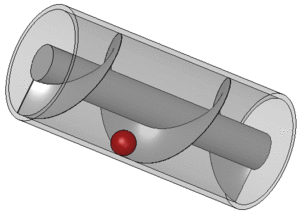
Much of Archimedes' engineering work helped his home city of Syracuse. King Hiero II asked Archimedes to design a huge ship called the Syracusia. This ship was for luxury travel, carrying supplies, and showing off naval power. The Syracusia was said to be the largest ship built in ancient times. It could carry 600 people and had gardens, a gym, and a temple. To remove any water leaking into the ship, Archimedes designed a device with a turning screw-shaped blade inside a cylinder.
Archimedes' screw was turned by hand. It could also move water from low areas to irrigation canals. The screw is still used today to pump liquids and dry materials like coal and grain. Archimedes' device might have been an improvement on an older screw pump used in the Hanging Gardens of Babylon. The first seagoing steamboat with a screw propeller, the SS Archimedes, was launched in 1839. It was named after Archimedes because of his work on the screw.
Archimedes' claw
Archimedes is also said to have designed a claw to defend Syracuse. It was also called "the ship shaker." The claw was like a crane with a large metal grappling hook. When the claw dropped onto an attacking ship, the arm would swing up. This would lift the ship out of the water and sometimes sink it.
Modern experiments have tested if the claw could really work. In 2005, a TV show called Superweapons of the Ancient World built a version of the claw. They found that it was a workable device.
Mathematics
Archimedes is known for his mechanical devices, but he also made huge contributions to mathematics.
He proved many geometrical theorems. These included how to find the area of a circle. He also found the surface area and volume of a sphere. He figured out the area of an ellipse and the area under a parabola. He also found the volume of parts of shapes like a paraboloid of revolution and a hyperboloid of revolution. He even found the area of a spiral.
His other math achievements include finding a very good approximation of pi. He also defined and studied the Archimedean spiral. He even created a system using exponentiation to write very large numbers.
Spherical geometry
In his work On the Sphere and Cylinder, Archimedes showed important facts about spheres. He proved that the surface area of a sphere is four times the area of its great circle. He also showed that the volume of a sphere is two-thirds the volume of a cylinder that perfectly encloses it.
Archimedes at war
Archimedes also invented or improved many machines used in war. For example, he made better catapults. This was during the Punic Wars, which were battles between Rome (in modern Italy) and the city of Carthage (in modern North Africa). For many years, he helped stop the Roman army from attacking Syracuse, his city.
Another story about Archimedes says he burned Roman ships from far away. He supposedly used many mirrors and the light from the sun. This might be possible, but it is more likely that flaming missiles from a catapult were used.
Legacy
Archimedes is sometimes called the father of mathematics and mathematical physics. He had a huge impact on math and science. Historians of science and mathematics generally agree that Archimedes was the best mathematician from ancient times.
Galileo called him "superhuman" and "my master." Huygens said, "I think Archimedes is comparable to no one." Leibniz believed that understanding Archimedes and Apollonius would make people admire later mathematicians less. Gauss admired Archimedes and Newton the most.
The inventor Nikola Tesla also praised him, saying:
Archimedes was my ideal. I admired the works of artists, but to my mind, they were only shadows and semblances. The inventor, I thought, gives to the world creations which are palpable, which live and work.
Honors and commemorations
The Fields Medal, a top award in mathematics, has a picture of Archimedes on it. It also shows a carving of his proof about the sphere and the cylinder. The words around his head mean: "Rise above oneself and grasp the world."
Archimedes has appeared on postage stamps from many countries. These include East Germany (1973), Greece (1983), Italy (1983), Nicaragua (1971), San Marino (1982), and Spain (1963).
Interesting facts about Archimedes
- Archimedes was the first known Greek to record many dates and times of the solstice.
- The famous shout of Eureka! is the state motto of California.
- In his book Measurement of a Circle, Archimedes gave a very accurate estimate for the square root of 3.
- He discussed how big the Earth, Sun, and Moon are. He also talked about Aristarchus' idea that the Earth goes around the Sun. He did this without using trigonometry.
- There is a crater on the Moon named Archimedes in his honor. There is also a lunar mountain range, the Montes Archimedes.
- A sculpted sphere and cylinder were placed on Archimedes' tomb, as he had asked.
- Leonardo da Vinci greatly admired Archimedes. He even said Archimedes invented his own machine called the Architonnerre.
Archimedes quotes
- "Give me a place to stand and with a lever I will move the world."
- "Those who claim to discover everything but produce no proofs of the same may be confused as having actually pretended to discover the impossible."
- "I have found it!" or "I have got it!", commonly quoted as "Eureka!"
Images for kids
-
Ostomachion is a dissection puzzle found in the Archimedes Palimpsest.
-
The Fields Medal has a portrait of Archimedes.
-
Bronze statue of Archimedes in Berlin
See also
 In Spanish: Arquímedes para niños
In Spanish: Arquímedes para niños


